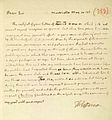File:Jefferson Heaton Letter 1826.jpg
Jefferson's public silence on slavery :
In a letter to James Heaton, Whig state representative from Ohio, Thomas Jefferson explained his public stance on slavery. Near the end of his life Jefferson justified his inaction for trying to end slavery during his presidency with the following explanation in a letter to James Heaton:
In a letter to James Heaton, Whig state representative from Ohio, Thomas Jefferson explained his public stance on slavery. Near the end of his life Jefferson justified his inaction for trying to end slavery during his presidency with the following explanation in a letter to James Heaton:
- DEAR SIR, -- Monticello, May 20.26
The subject of your letter of April 20, is one on which I do not
permit myself to express an opinion, but when time, place, and occasion
may give it some favorable effect. A good cause is often injured more
by ill-timed efforts of its friends than by the arguments of its enemies.
Persuasion, perseverance, and patience are the best advocates
on questions depending on the will of others. The revolution in
public opinion which this cause requires, is not to be expected in
a day, or perhaps in an age; but time, which outlives all things,
will outlive this evil also. My sentiments have been forty years before
the public. Had I repeated them forty times, they would only have
become the more stale and threadbare. Although I shall not live to
see them consummated, they will not die with me; but living or
dying, they will ever be in my most fervent prayer. This is
written for yourself and not for the public, in compliance with your
request of two lines of sentiment on the subject. Accept the assurance of
my good will and respect.
- -- Thomas Jefferson.'
- -- Thomas Jefferson.'
Note
- ↑ Thomas Jefferson, Legacy. Library of Congress. Retrieved on July 25, 2014.
